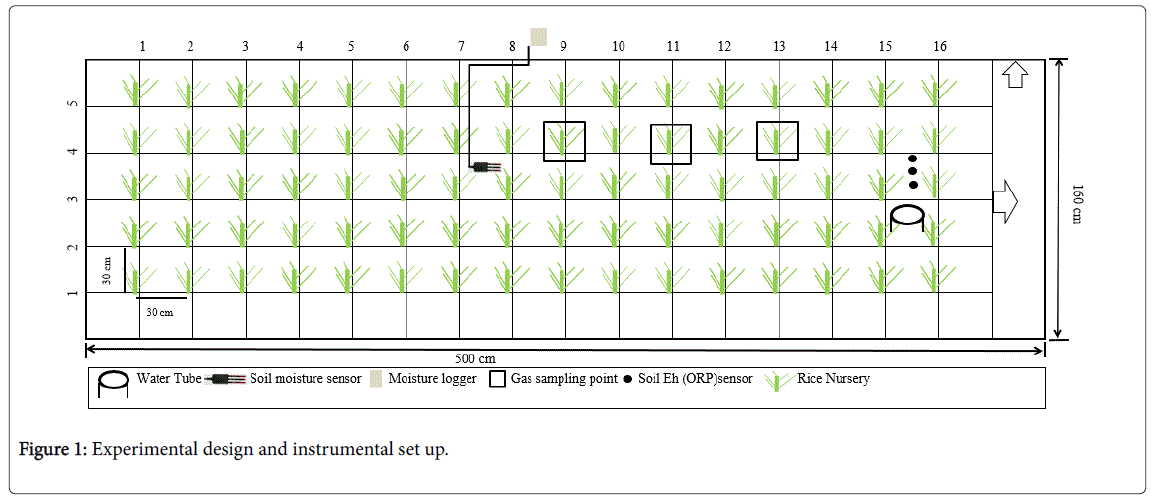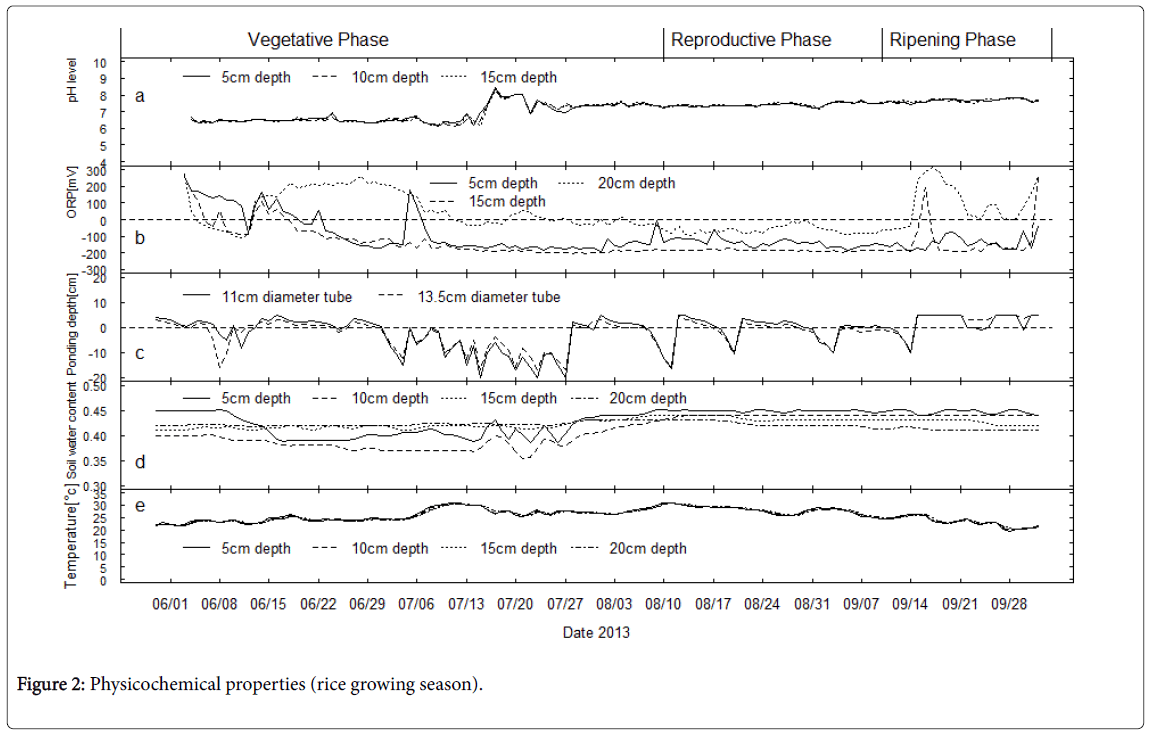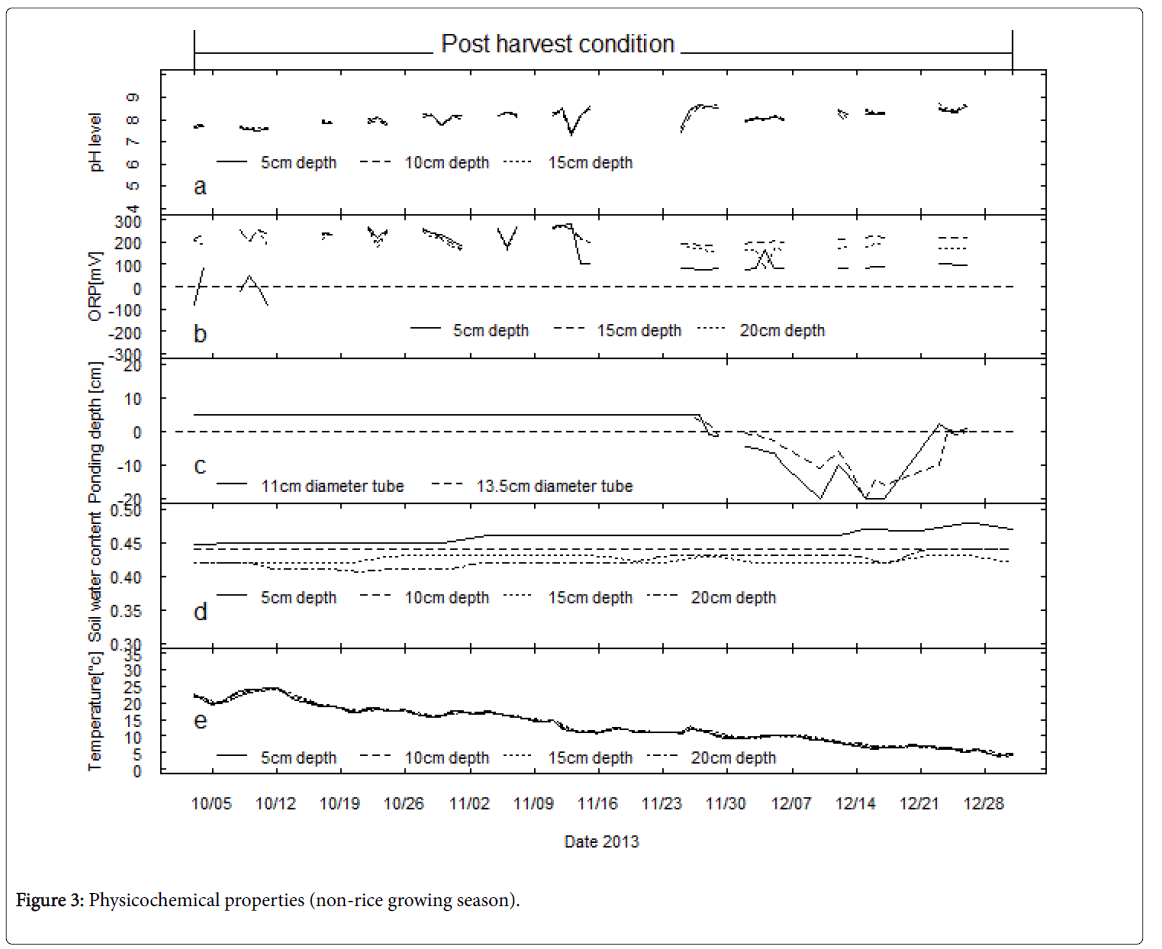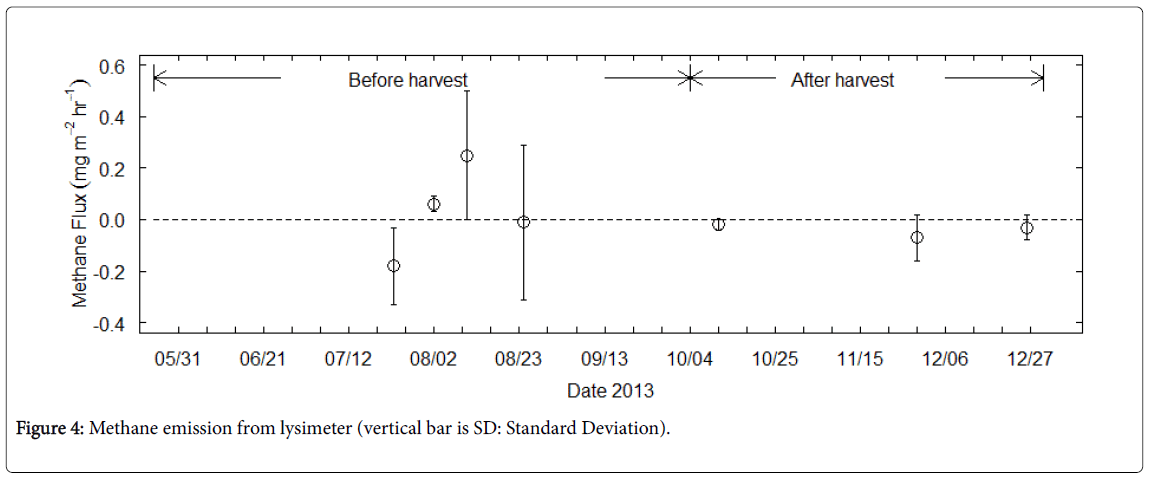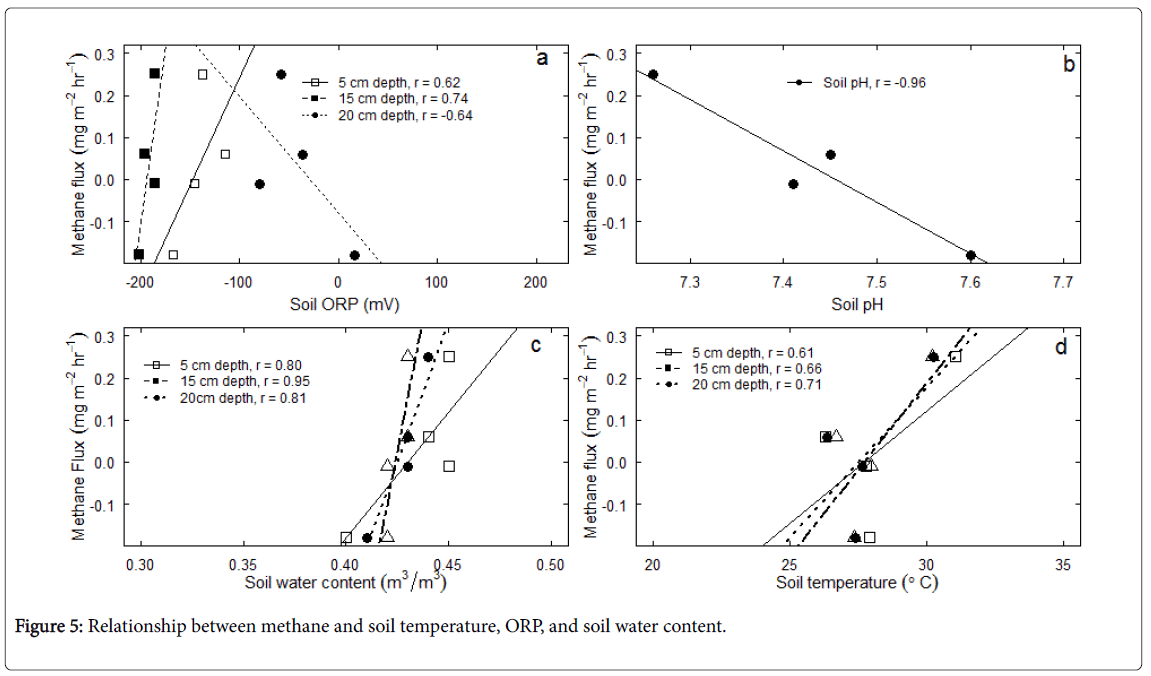Research Article Open Access
Methane Emission Trend based on the Water Management during Rice Growing and Non-growing Seasons
Graduate School of Frontier Sciences, The University of Tokyo, Kashiwanoha 5-1-5, Kashiwa City, Chiba Prefecture 277-8563, Japan
- Corresponding Author:
- Ishwar Pun
Graduate School of Frontier Sciences
The University of Tokyo, Kashiwanoha 5-1-5
Kashiwa City, Chiba Prefecture 277-8563, Japan
Tel: +81-4-7136-4850
Fax: +81-4-7136-4842
E-mail: punisr@gmail.com
Received Date: 21 June, 2016; Accepted Date: 22 September 2016; Published Date: 29 September 2016
Citation: Pun I, Yamaji E (2016) Methane Emission Trend based on the Water Management during Rice Growing and Non-growing Seasons. J Rice Res 4:176. doi: 10.4172/2375-4338.1000176
Copyright: © 2016 Pun I, et al. This is an open-access article distributed under the terms of the Creative Commons Attribution License, which permits unrestricted use, distribution, and reproduction in any medium, provided the original author and source are credited.
Visit for more related articles at Rice Research: Open Access
Abstract
Paddy fields are thought to be a major greenhouse gases emitter. Several studies have investigated the reduction of greenhouse gases emission from paddy fields by applying AWD irrigation (alternative wetting and drying), a method of water management practiced during rice growing seasons. However, few studies have conducted lysimeter experiments in which the irrigation, fertilizers, and drainage system are controlled to reduce the emission. Therefore, this study was conducted in a small scale lysimeter (500×160) cm2 on the rooftop of the Environmental Studies Building in the Kashiwa campus of the University of Tokyo from May to December 2013 to investigate methane emission patterns by observing depth-wise physicochemical properties of the soil. Soil pH, ORP (Oxidation Reduction Potential), temperature, and water content were also recorded at different soil depths of 5 cm, 10 cm, 15 cm and 20 cm. Japanese rice variety Koshihikari was transplanted, and the plant was irrigated depending on rainfall events throughout the experiment. Gas sampling was performed based on the ponding condition of the lysimeter. The results showed that methane flux occurred when the ORP dropped to -150 mV at a level 5 to 15 cm deep from the upper soil surface. The methane flux was higher during the rapid development of rice plants in vegetative phase. Methane flux also showed a positive correlation with soil water content and temperature at different soil depths. The global warming potential during rice growing and non-growing seasons from total methane emission was 0.72 and -0.21 g CO2 m-2 respectively. The results suggest that avoiding water stress for plants by a proper water management during vegetative phase is effective for the mitigation of methane release.
Keywords
Methane flux; Lysimeter; Water management; ORP; Ponding depth; Soil temperature
Introduction
Rice, one of the most important cereals, has a long history in Asia. The demand for rice is rising with the increasing population. The more activities take place in agriculture, the more they can directly affect the environment and indirectly add to the environmental load. Paddy fields are thought to be a major emitter of GHGs (greenhouse gas) such as methane, nitrous oxide, and carbon dioxide [1]. In 2007, IPCC reported that agriculture contributed about 14% of GHG emission annually [2]. Many techniques involving the control of resources like water and fertilizers are known as ways to increase rice production. Few studies have conducted lysimeter experiments to study the methane emission with water management. For example, [1] showed that percolation of soil organic matters and nutrients through water drainage from the rice paddies decreases methane gas emission.
Continuous flooding of paddy fields is known to release a significant amount of greenhouse gas. The management of water, and in particular mid-season drainage, is an effective measure for reducing the methane flux from rice fields [3-6]. Some of the sustainable rice practices have been in existence already, such as the SRI (System of Rice Intensification) which was introduced first to Madagascar. SRI is a new technique for the farmers for improving the rice production by controlling water, soil nutrients, and plants in the paddy fields. It is known to produce higher yields, save water, and reduce fertilizer use compared to conventional rice practices [7,8]. Another effective water management called AWD irrigation (Alternate Wetting and Drying) is a practice in which rice fields are irrigated intermittently instead of keeping them ponded during rice growing seasons. Research has shown that AWD irrigation effectively saves water compared to conventional practices without reducing the rice yield [9,10].
Past paddy field experiments showed that the emission rate of methane differed by soil types, and compost application as well as water management such as intermittent drainage can be an appropriate option for reducing the greenhouse gas emission from paddy fields [4,11]. Moreover, some researchers suggested that methane emission from the paddy fields occurs through ebullition and low atmospheric condition [12]. The lysimeter experiment by Yagi et al. [13] showed that GHG is reduced by intermittent irrigation. Nonetheless, studies on the mechanism of methane emission are limited with respect to water management and physicochemical properties of the soil in depth-wise. This study investigated the methane flux patterns and physicochemical properties of the paddy soil during and after the rice paddy cultivation observing the depthwise soil layer condition. Our hypothesis was that physicochemical properties of soil differ in depthwise based on water management in paddy field.
Methodology
Experimental design and instrumental set up
The lysimeter experiment was conducted to study the pattern of greenhouse gas emission in rice cultivation with water management. The size of lysimeter is 500×160 cm, situated on the rooftop of a building of the University of Tokyo in Chiba Prefecture. The study was conducted from the beginning of May to the end of December in 2013.
The Japanese rice variety Koshihikari was transplanted on May 29. Based on the size of the lysimeter, 80 seedlings were transplanted in the spacing of 30×30 cm (Figure 1).
In order to study methane gas emission from the paddy field in detail, soil moisture sensors were set up to measure soil ORP. The pH and ORP were measured by using PRN-41 (Fujiwara Company, Tokyo). Before using the pH meter, the sensors were calibrated by using a standard solution of pH 6.86 and pH 4.01. Soil pH, ORP, and ponding water depth were recorded once a day. The soil moisture and temperature at 5, 10, 15 and 20 cm depths were measured by ECH2O-5TE sensors (DECAGON DEVICES, USA). The soil moisture and temperature were adjusted and continuously recorded every 60 minutes throughout the experimental process. Water tubes were installed near the edge of lysimeter to check ponding depth.
To study the rice plant development, plant height and number of its tillers and leaves were noted every 7-10 days. AWD irrigation was applied throughout the experiment; gas was trapped depending on the ponding condition. Gas samples were taken during vegetative and reproductive phases of rice on July 23, August 1, August 10, and August 24, and after harvest on October 11, November 24 and December 26. Gas was collected using the chamber method from three points on the lysimeter at 10 minute interval. The collected gas was analysed using gas chromatography GC-14a (Shimadzu, Japan). R software was used for both graphical and statistical analyses (version 3.1.0).
Climatic Features
The wet season starts from early June to August in Japan, while rice cultivation starts in the summer when humidity is high. The total rainfall during the rice farming season was 171.0 mm by June and maximum daily rainfall was 60.5 mm. The average maximum temperature was in August, i.e. 27.2ºC, and daily maximum was also recorded the same month. The maximum sunshine hours were recorded on August 29th according to Abiko Meteorological Station, Chiba, Japan.
Result and Discussion
Water management
Ponding depth was observed by a water tube in the lysimeter experiment. AWD irrigation was applied during the initial phase of the experiment, but frequent rainfall was observed after mid-September to the end of November. Tap water was supplied for irrigation whenever the water level dropped below the soil surface. The lysimeter was in flooded condition until the end of December. Water level in the driest condition was at 20 cm below the soil surface and the highest ponding level was at 5 cm above the surface (Figure 2). Whenever ponding water falls down the soil surface, irrigation was supplied. The lysimeter was left without water managing after harvest.
Physicochemical properties of the lysimeter during vegetative and reproductive phases
Soil moisture and temperature data were recorded every 60 minutes throughout the experiment, and soil ORP and pH were measured manually once a day. As shown in Figure 2, moisture content at 5 cm and 10 cm depths were greatly affected by AWD irrigation. The figure indicates that moisture at the surface layer percolated faster in a drier condition. Figure 2 shows that the ponding depth was below the surface throughout much of May until August, during which the moisture content also dropped. However, less effect on moisture at 15 cm and 20 cm depths were observed. During the wet season, when the ponding depth was above the surface, moisture content at every depth level increased and almost stayed constant with little fluctuation. In addition, temperature fluctuated up and down in contrast with the moisture content. Moreover, much of the lowland rice field soil is clayey with higher water holding capacity compared to other soil types. Water retention capacity of soil may be the reason for the smaller soil moisture impact at 15 and 20 cm depths.
Figure 2 shows that the temperature increased at every depth during the initial phase starting summer season in study area. Temperature reached to the pick at the end of vegetative phase. Moisture was constant after harvest since the ponding depth in lysimeter was constant, as shown in Figure 2 (above the surface level), and temperature decreased rapidly once winter season arrived.
After the transplantation of rice on May 29 during the initial phase, pH value remained constant until middle of July (Figure 2). pH value steadily increased (in alkaline condition) afterwards. Soil ORP values at every depth were highly fluctuating during the initial phase because a soil solution was mixed with the plow layer, causing changes in oxidation ability of rice roots. Lysimeter was ponded after mid-July due to the rain and irrigation. This caused the soil ORP to drop gradually in reducing condition as shown in Figure 2. Oxygen gas in the plow layer was deficient when lysimeter was kept under the ponding condition. Soil ORP value at 20 cm depth was higher (positive), which indicates that more oxidization occurred. However, given that the value should have been lower (negative) by depthwise, the concrete used for the building may have had an impact on the lysimeter environment.
Post-harvest condition (non-rice growing season)
The lysimeter was left in a natural condition after the rice harvest and its physicochemical properties were observed. Soil pH, ORP, and ponding condition was measured irregularly, while soil temperature and moisture were measured every 60 minutes as before. The ponding depth was positive until the end of November, and lower down through December. Because of the anaerobic condition of the soil, ORP was higher up to November but decreased through December (Figure 3). The moisture content was neutral while temperature decreased at every depth as winter arrived. The results showed that methane is not released from the paddy fields if they are left fallow.
Methane flux
Lysimeter was flooded for two weeks after the transplantation, and AWD irrigation was applied afterwards in accordance with amount of rainfall while the rice nursery was still strong. The first gas sampling was conducted on July 23 when the ponding water was 15 cm below the surface, given that methane flux decreased when ponding depth dropped. The methane flux at this time was below zero, and soil ORP values were also negative at 5 cm and 15 cm depths, and only slightly positive at 20 cm depth (Figure 2). Methane flux was observed for the second and third sampling on August 4 and 10, respectively (Figure 4). There was less flux after August 10. The results indicate that methane flux increases with the rapid development of rice plants during the vegetative phase. If the irrigation can be controlled without inducing water stress to the rice plant, then AWD irrigation is an appropriate measure for mitigating methane. Methane flux was less during the reproductive phase where rice plant height, tillers, and leaves develops and panicles reach maturity slowly. The methane flux during the postharvest management was less in our experiment, which was also similar to the results by Nishimura et al. [6]. The global warming potential during rice growing and non-growing seasons from total methane emission was 0.72 and -0.21 g CO2 m-2 respectively.
Relationship between methane and soil pH, ORP, and soil water content
Data obtained during vegetative and reproductive phases were used to evaluate the methane flux pattern in AWD irrigation by observing the soil physicochemical properties during the rice-growing and nonrice growing seasons.
The methane flux with soil ORP, pH, soil moisture content, and temperature were analysed using a simple correlation process. The negative correlation between soil ORP and methane flux, in which suppressing the oxygen reduction process in the soil increases the methane flux. Measurements were taken at fixed depths of 5, 15, and 20 cm. ORP values at 5 and 15 cm were lower at the beginning of the sampling process, and later increased to a level where methane flux with ORP was positive at 5 and 15 cm depths, and negative at 20 cm depth. Many studies, including Yagi et al. [1,14], checked the soil ORP only at 5 cm depth and methane emission was observed whenever soil ORP decreased to -150 mV. While soil ORP in this study was similar to that of the past studies at 5 and 15 cm depths, ORP was higher at 20 cm depth. The soil water content and temperature showed a positive correlation with methane flux (Figure 5), even though soil water content depends largely on ponding condition and soil types. The soil pH with methane flux showed the negative correlation (Figure 5). In a non-rice growing season, soil ORP was positive and methane flux was negative, which is consistent with the observations by Kudo et al. [13,15].
Conclusions
The experiment conducted in lysimeter identified methane flux during the vegetative phase. Methane flux was also greater with the presence of active soil microorganism during the rapid development of rice plant height, leaves, and tillers. Moreover, the experiment showed that methane is being released whenever soil ORP is low in the soil layer. When the soil ORP value is higher, the methane emission is lower. The study has also shown that the temporal measurement of soil ORP varies at each soil depths. While many studies measured soil ORP only at 5 cm depth and showed negative correlation but results from this study showed a negative soil ORP correlation only at 20 cm depth, which is logical for the methane emission mechanism. The positive correlation between methane flux and soil ORP at 5 and 15 cm depths showed that the less formation of methanogenic bacteria. The moisture and temperature at each depth showed a positive correlation with methane flux. The result showed that maximum soil ORP did not fall below -201 mV during gas measurement process. A decrease in soil ORP may be affected by water management. However, this was a lysimeter experiment conducted on the roof of a building, and there may have been some heat effect at the bottom nearer of 20 cm depth, which is different from a paddy field environment. Experiments on real paddy fields are need to better understand the mechanism of methane flux with respect to soil physicochemical properties. Moreover, the soil organic matter in a depth wise direction needed to be measured in the paddy field.
References
- Yagi K, Minami K, Ogawa Y (1998) Effect of water percolation on methane emission from rice paddies: a lysimeter experiment. Plant Soil 198: 193-200.
- Smith P, Martino D, Ca Z, Gwary D, Janzen H, et al. (2007) In: Metz B, Davidson OR, Bosch PR, Dave R, Meyer LA (ed.) Agriculture. In Climate Change 2007: Mitigation. Contribution of Working Group III to the Fourth Assessment Report of the Intergovernmental Panel on Climate Change, Cambridge University Press, Cambridge, United Kingdom.
- Berger S, Jana I, Seo J, Kang H, Gebauer G (2013) A record of N2O and CH4 emissions and underlying soil processes of Korean rice paddies as affected by different water management practices. Biochemistry 115: 317-332.
- Hadi A, Inubushi K, Yagi K (2010) Effect of water management on greenhouse gas emissions and microbial properties of paddy soils in Japan and Indonesia. Paddy Water Environ 8: 319-324
- Li C, Qiu J, Frolking S, Xiao X, Salas W, et al. (2002) Reduced methane emissions from large-scale changes in water management of China’s rice paddies during 1980-2000. Geophys Res Lett 29: 1972.
- Nishimura S, Sawamoto T, Akiyama H, Sudo S, Yagi K (2004) Methane and nitrous oxide emissions from a paddy field with Japanese conventional water management and fertilizer application. Global Biogeochem Cycles 18: 2004.
- Chapagain T, Yamaji E (2010) The effects of irrigation method, age of seedling and spacing on crop performance, productivity and water-wise rice production in Japan. Paddy Water Environ 8: 81-90.
- Hasan M, Sato S (2007) Water saving for paddy cultivation under the system of rice intensification (SRI) in eastern Indonesia. J Tanah Lingk 9: 57-62.
- Chapagain T, Riseman A, Yamaji E (2011) Achieving More with Less Water: Alternate Wet and Dry Irrigation (AWDI) as an Alternative to the Conventional Water Management Practices in Rice Farming. J AgricSci3: 81-90.
- Choi J, Kim G, Park W, Shin M, Choi Y, et al. (2014) Effect of SRI methods on water use, NPS pollution discharge and GHG emission in Korean trials. Paddy Water Environ 13: 205-2013.
- Yagi K, Minami K (2012) Effect of Organic Matter Application on methane Emission from Japanese Paddy Fields. Soil Sci Plant Nutr 36: 599-610.
- Tokida T, Miyazaki T, Mizoguchi M (2005) Ebullition of methane from peat with falling atmospheric pressure. Geophys Res Lett 32.
- Kudo Y, Noborio K, Shimoozono N, Kurihara R (2014) The effects of Water Management Practices for mitigating gas emission and maintaining rice yield in central Japan. AgricEcosyst Environ 186: 77-85.
- Minamikawa K, Sakai N (2006) The practical use of water management based on soil redox potential for decreasing methane emission from paddy field in Japan. AgriEcosyst Environ 116: 181-188.
- Zhang A, Bian R, Pan G, Cui L, Hussain Q, et al. (2012) Effects of biochar amendment on soil quality, crop yield and greenhouse gas emission in a Chinese rice paddy: A field study of 2 consecutive rice growing cycles. Field Crops Res 127: 153-160.
Relevant Topics
- Basmati Rice
- Drought Tolerence
- Golden Rice
- Leaf Diseases
- Long Grain Rice
- Par Boiled Rice
- Raw Rice
- Rice
- Rice and Aquaculture
- Rice and Nutrition
- Rice Blast
- Rice Bran
- Rice Diseases
- Rice Economics
- Rice Genome
- Rice husk
- Rice production
- Rice research
- Rice Yield
- Sticky Rice
- Stress Resistant Rice
- Unpolished Rice
- White Rice
Recommended Journals
Article Tools
Article Usage
- Total views: 13307
- [From(publication date):
December-2016 - Mar 31, 2025] - Breakdown by view type
- HTML page views : 12238
- PDF downloads : 1069

